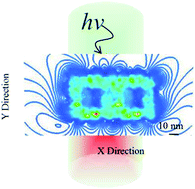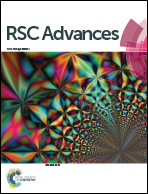The unusual visible photothermal response of free standing multilayered films based on plasmonic bimetallic nanocages†
Abstract
An optical phenomena based on the incident light absorption and transduction to the detectable thermal signal by plasmonic bimetallic Ag and Au nanocages (Ag@AuNCs) has been researched on free standing layer-by-layer (LbL) films of poly(vinyl alcohol) (PVA) and poly(vinyl pyrrolidone) (PVPON), (PVA/PVPON_Ag@AuNCs). Unlike well-studied monometallic Au nanocages (NCs), which possess a photothermal response in the near-infrared region, the bimetallic nanocages show a pronounced photothermal response in the visible range (532 nm) and near-infrared range (780 nm) due to the presence of two characteristic peaks at both wavelength ranges. The photothermal response in the visible range (532 nm) is distinguishable. Specifically increasing the laser power to 100 mW led to visual burning of the free standing film (temperature increased greater than >150 °C). The photothermal response by (PVA/PVPON_Ag@AuNCs)n films increases in proportion to the number (n) of bilayers (bl). It also increases as the molar concentration of the Ag@AuNCs introduced to the PVPON layer is increased. Therefore the molar concentration of the plasmonic Ag@AuNCs in (PVA/PVPON_Ag@AuNCs)n films is a primary factor that affects the photothermal dynamic response along with Ag@AuNCs distribution. This is supposed to result from the Ag@AuNCs assembled in a layer that leads to electromagnetic field enhancement. The unusual observation in multilayered (PVA/PVPON_Ag@AuNCs)n films is that the UV-visible spectra (extinction efficiency) and photothermal response (Tmax) do not rely on the content of the adjacent layer of PVA and show a comparable (by value in magnitude) photothermal response at a different PVA composition of 2 mg ml−1 and 20 mg ml−1 at the same Ag@AuNCs concentration in the PVPON layer.


 Please wait while we load your content...
Please wait while we load your content...